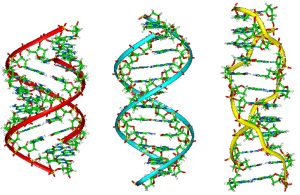While many medical conditions are well known and easy to diagnose, others remain total mysteries. Some cases might seem mundane at first, only to end up baffling doctors and other medical professionals for decades, if not centuries.
From waking up one day with a foreign accent to remaining trapped in the body and mind of a toddler even as a person ages, these weird, unexplained conditions are a reminder of how difficult it can be to fully understand how the human body works. And sometimes what we do learn is disturbing – especially when there is no known cure.
We present a dozen rare medical conditions that have challenged and baffled the medical world.
Martin Pistorius Spent 12 Years Trapped In His Own Body, Unable To Communicate
In the late 1980s at age 12, Martin Pistorius of South Africa came down with a strange illness. His doctors weren’t sure what it was, but the prevailing thought was cryptococcal meningitis. He got progressively worse: first he lost the ability to move by himself, then his ability to make eye contact, and finally his ability to speak. His parents were told their son was essentially in a vegetative state, that he wasn’t “really there,” and would die soon.
But he didn’t die. For the next 12 years, his parents took care of him – bathing, dressing, and feeding. One day, not knowing her son could hear her, Joan Pistorius told him: “‘I hope you die.’ I know that’s a horrible thing to say,” she told NPR in 2015. “I just wanted some sort of relief.”
But he did hear her. Pistorius began to wake up between the ages of 14 and 16. “I was aware of everything, just like any normal person,” he later recalled. His condition is known as locked-in syndrome, which can be caused by a stroke, traumatic brain injury, infection, or drug overdose. There is no known cure.
Although Pistorius could see, hear, and understand everything, he couldn’t move his body. “Everyone was so used to me not being there that they didn’t notice when I began to be present again,” he told NPR. “The stark reality hit me that I was going to spend the rest of my life like that – totally alone.”
He explained that he would disengage from his thoughts as a way to cope. Oddly, it was his hatred of the children’s TV show Barney, which he was forced to watch daily at the care center where he spent much of his time, that led him to start reengaging with his thoughts in an attempt to take some control of his life.
As his thoughts improved, so did his body. It was a relief worker at his daycare center who noticed his slight movements and realized Pistorius could communicate. She encouraged his parents to get another evaluation, where his consciousness was finally realized. By age 26, he could use a computer to communicate. He eventually enrolled in college to study computer science and started a company online. In 2011, he published his memoir, Ghost Boy. He is now married and a father of one.

Natalie Adler Can’t Open Her Eyes For Days At A Time
Natalie Adler was 17 when she woke up one morning to find her eyelids mysteriously swollen, which was odd, but not necessarily alarming. However, her condition quickly deteriorated.
“[My eyes] just developed into this random cycle where they would spasm shut for three days then open for three days,” Adler told 7 News in 2017, 13 years after her condition first appeared.
The problem has not only baffled her doctors, but it’s so rare that it doesn’t even have a name. Adler is now legally blind after having undergone several unsuccessful surgeries that removed 99% of the muscles in her eyelids. And while Botox kept her eyes partially open, she still continued to suffer from random bouts of blindness every month.
In her news interview, Adler said she remained hopeful of finding a cure: “I never lose hope because I just can’t – that’s not the person I am.”

When Brooke Greenberg was born in 1993, she weighed just four pounds. Aside from her anterior hip dislocation, which was corrected through surgery, she appeared to be a normal child. But as she aged, her mind and body remained those of a toddler.
For the first few years of her life, Brooke grew a bit. “But age 4, 4 to 5, she stopped,” Greenberg’s father Howard told Katie Couric on Katie in 2013.
At the time of that TV appearance, the 20-year-old girl stood less than three feet tall and weighed around 16 pounds. Because of her small esophagus, she had to get nutrition through a feeding tube. She wore diapers and communicated as if she were still a baby of six months, according to her mother Melanie. “If she’s happy, she’ll giggle and laugh,” she explained.
The Greenbergs visited dozens of specialists over the years, looking for answers about their daughter’s condition. But the doctors were baffled, telling the couple that they knew of no other person with the same condition.
“[The specialists] just said she’ll catch up. Then we went to the nutritionist, the endocrinologist. We tried the growth hormone,” Melanie told NBC News in 2005. It was after the growth hormone failed to produce any results that the family started hearing “Syndrome X,” the term at the time for Brooke’s unknown syndrome.
In addition to not developing mentally or physically, Brooke experienced numerous other serious medical problems, including a stroke and a brain tumor, both of which amazingly resolved with apparently no damage. More than once, her family was told to prepare themselves for her death.
Brooke lived until Oct 24, 2013, when she passed at age 20 due to bronchomalacia, a weakening of cartilage in the lungs’ bronchial tubes. In 2017, her condition was renamed neotenic complex syndrome, and a few other children have been discovered with it.

Ashleigh Morris Is Allergic To Water
The human body consists of approximately 60% water. But some people are allergic to water, which forces them to deal with a condition known as aquagenic urticaria. It’s a very rare malady (as of 2014, there were fewer than 50 known cases), and symptoms generally begin at the onset of puberty.
Australian Ashleigh Morris has dealt with the condition since she was 14. If her skin comes into any contact with water of any temperature, including sweat, she breaks out into sore, itchy red hives, primarily on her upper body. And it’s incredibly painful, to the point that she can only stand to shower for a minute or so at a time.
“There’s been many occasions where I’ve been so itchy, I’ve made myself bleed from scratching,” a then 19-year-old Morris told The Daily Mail in 2008.
Although the hives tend to disappear within a few hours, there is no known cause for aquagenic urticaria, nor is there a cure.

Gary Dockery Woke Up From A 7-Year Coma, Started Talking, And Fell Back Into A Coma
On September 17, 1988, Gary Dockery, a police officer in Walden, TN, responded to a 911 call, only to be shot point-blank in the head. The shooter, Samuel Frank Downey, told the police he had made the fake 911 call to get revenge for being reprimanded for making too much noise.
For the next seven years, Dockery lay in what was thought to be a coma, or perhaps a persistent vegetative state, occasionally grunting or blinking his eyes. About 20% of his brain had been destroyed in the shooting.
Early in February 1996, Dockery’s family learned he had pneumonia and would likely die if he didn’t have surgery. He was transferred to a Chattanooga hospital and put on antibiotics after having fluid removed from his lungs. His sister was at his bedside when she noticed something was different – his eyes were wide open.
After she told him she was his sister, they then shared this exchange, according to the AP:
“Uh-huh,” he responded.
“You’re talking!” she exclaimed.
“I sure am,” he answered brightly.
Dockery thought it was still 1988, and didn’t remember being shot, but amazed his family and doctors by how much recall he had about his life. “He talked himself to death that day,″ his son Shane said. “It was unbelievable.″
When they heard about his recovery, neurologists who knew about his case doubted that he’d been in a persistent vegetative state. The fact that he’d been able to blink “yes” or “no” suggested he’d been in a state of some awareness – a condition called a minimally responsive state or minimally conscious state.
The family’s joy at his recovery was short-lived. Dockery woke up on a Monday, but by Wednesday of that week, he had stopped talking. He survived the surgery to clear out his lungs but remained paralyzed and gradually fell back into a semiconscious state. He passed in April 1997 at the age of 43.

Gabby Gingras Can’t Feel Pain
When Gabby Gingras was a baby, she would bite her hands so severely that her mother described them as looking “like raw hamburger.” But she didn’t cry.
This was the first symptom of what was later diagnosed as congenital insensitivity to pain with anhidrosis, a rare nervous system disorder that leaves her immune to feeling any pain; she also cannot sweat. CIPA is so rare that when Gingras was diagnosed, her doctors could find only a dozen or so people in the world known to have the condition.
There is no known cure. The inability to feel pain resulted in Gingras scratching her eyes so severely that she is legally blind. In 2004, her left eye had to be removed and replaced by a prosthesis, and to protect her remaining eye, she wore swim goggles. CIPA also cost her most of her teeth; she either broke them off biting her toys or they were voluntarily removed after she damaged her mouth so severely that she had to be hospitalized.
Gingras’s story first received attention when a local TV station in Minnesota did a story on her as a 3-year-old. The story resurfaced in 2018 when her insurance company refused to cover the costs of a dental procedure that would rebuild the teenager’s jaw and implant new teeth, claiming the procedure wasn’t medically necessary.
Shortly after the story broke, Delta Dental volunteered to pay for the surgery.

A Norwegian Woman Was Hit By Shrapnel And Started Speaking In A German Accent
If someone suddenly starts speaking in an accent other than their own, they could have foreign accent syndrome, a rare brain disorder that occurs most frequently after a stroke or traumatic brain injury. One of the earliest well-documented cases involved a Norwegian woman named Astrid who suffered a brain injury after being hit by shrapnel during a German air raid in WWII.
Although she had never been out of Norway, following her accident she started speaking with a strong German accent. She was ostracized by many Norwegians, as she was thought to be German. And of course, Germany and Norway were enemies during WWII – the former even occupying the latter for several years. It got so bad for Astrid that some storekeepers refused to sell her any goods.
FAS apparently affects speakers of any language; in 2018, an Arizona woman went to bed with a migraine and woke up with a British accent. Only about 100 documented cases exist to date. The phenomenon seems to occur when Broca’s area of the brain (which is responsible for speech) is damaged.

Karen Keegan’s DNA Said She Wasn’t Related To Her Own Sons
When Karen Keegan was tested to see if any of her three sons was a potential match for her second kidney transplant (the first one had failed), the results showed that while the three were brothers, two of them weren’t Keegan’s biological sons.
“We thought there was a problem with testing; that there was a mistake. So we had her retested and examined and… it showed the same thing,” said Lynne Uhl, a transfusion medicine specialist at Boston’s Beth Israel Deaconess Medical Center. “We knew this woman very well and knew without any doubt that she was the mother of these kids. That prompted us to look more carefully for an explanation for this finding.”
Further testing revealed Keegan was a chimera – a person composed of two genetically distinct cellular lines. Chimeras who are not born with an actual twin are thought to possess cells from a twin who died early in gestation. In Keegan’s case, Uhl said,
We hypothesized that two eggs were fertilized and very early on fused together. It wasn’t that there actually was a twin that went fairly far along in development, then was resorbed, but more likely that very early on the two fertilized eggs fused together.
Human chimeras like Keegan are very rare; as of 2014, only around 100 cases had been officially recorded.
Joey DeGrandis Can Perfectly Recall Almost Any Day Of His Life
The brain is a mysterious thing. Some people have vague or no specific memories about their past. A few people are blessed (or cursed) with a condition called highly superior autobiographical memory. As of 2017, fewer than 100 people were known to have the condition, which provides a near-perfect memory for recalling dates and events.
The first person diagnosed with HSAM was Jill Price, who in 2000 emailed Dr. James McGaugh (pictured), a professor in neurobiology and behavior at UC Irvine, about her memory problem. Price wrote: “Whenever I see a date flash on the television… I automatically go back to that day and remember where I was, what I was doing, what day it fell on…” She described the experience as “nonstop, uncontrollable, and totally exhausting.”
McGaugh started researching the condition, and in 2010, appeared on 60 Minutes to discuss his findings. Among the people who reached out to him after the segment aired was Joey DeGrandis, who had been aware of his near-perfect memory since he was 10. For years he had treated it as a kind of magic trick, even performing at a school magic show by accurately naming what day of the week any date in recent history fell on. But after seeing 60 Minutes, he decided to take part in McGaugh’s studies.
Research shows that many people with HSAM tend to have obsessive traits. DeGrandis told Time he felt his HSAM contributed to his occasional bouts of depression and anxiety, as he struggles to let go of certain things. The phenomenon is not the same as a photographic memory; people with HSAM have no advanced memory when it comes to remembering things like names or faces. “I’m not great with names, or with mundane details like whether I brushed my teeth today or where I put my keys,” DeGrandis admitted to Time in 2017.

Nicknamed “the Iceman,” Wim Hof, who was born in the Netherlands in 1959, is immune to freezing temperatures. He has set Guinness World Records for prolonged full-body contact with ice and for swimming under ice. Hof doesn’t attribute his accomplishments to any medical malady, but rather to his Wim Hof Method (WHM), which combines frequent exposure to cold, special breathing techniques, yoga, and meditation. It is the deep breathing that Hof claims is the cornerstone of WHM. His hope is that his method will eventually be widely accepted by and change the world of medicine.
Hof’s life was changed when, at age 17, he followed his sudden urge to strip down and jump into the half-frozen Beatrixpark canal. He did it again the next day, and then many more times over the following years. When his wife took her life in 1995, Hof started trying to popularize his methods. He said he saw a vision about how it could help people like his wife regain some control of their lives. But Hof had little success until a TV news crew filmed him jumping into a frozen lake to save a man who had fallen through the ice; soon after, Hof was tagged with the “Iceman” moniker.
In 2012, researchers in the Netherlands examined samples of Hof’s blood and determined that, as he had claimed, he was able to manipulate his immune system at will, allowing him to fight off any number of diseases. Two years later, researchers injected 12 WHM devotees with a toxin that normally caused nausea and flu-like symptoms, only to discover that the test subjects suffered mild to no effects.

King Charles VI ruled France from 1380 to 1422. Aside from being prone to wild rages – one of which occurred in 1392 when he slew four of his knights – he had some rather strange beliefs. One of these was that he was made of glass. He wore reinforced clothing to protect his body, and no courtiers were allowed anywhere near him. The rule must not have applied to his wife or mistress, as he fathered 13 children between them.
Charles was not the only person to experience this. In fact, medical and literary works from the 15th through 17th centuries make numerous mentions of people who believed they had glass bones, heads, or hearts. One story tells of a man who believed his rear end was made of glass; to avoid it shattering to pieces, he never sat down. He also never left his home, as he worried that a glazier might try to melt him down into a windowpane.
At the time, the medical term for people with this condition was a form of melancholia. Doctors thought it was caused by an excess of black bile in the body, which was believed to cause a glassy sheen. “Glass delusion,” as it’s now called, seemed to disappear around the 1830s, although contemporary cases have popped up. While it’s thought that the delusion appeared more when glass was a new commodity, much like “cement delusion” in the 19th century, modern cases may be linked to feelings of fragility.

George III was the king of Great Britain and Ireland from 1760 until his passing in 1820. In the latter part of his reign, he suffered recurrent bouts of erratic behavior that led to his son George, Prince of Wales, being named the acting regent in 1811, a role he held for the rest of his father’s life. George III’s doctors were not prepared to deal with an illness they could not diagnose – the medication they gave him was reportedly laced with poison, which just made his bouts of “madness” worse.
Researchers and scholars have yet to determine a definitive cause for this “madness.” Among various theories are bipolar disorder and a genetic blood disease, porphyria. In 2018 acute mania was suggested as the label for George’s episodes in a report published in the journal PLOS ONE. Acute mania is a hyperactive, excitable condition (which resembles the manic stage of bipolar disorder and can occur in people with bipolar disorder).
In this study, researchers used a computer program to study letters written by George III during his reign. The program identified 29 written features used to differentiate between people who have mental disorders and those who don’t. It found stark differences in letters written when George III was thought to be mentally sound, compared with those written when he was thought to be suffering from a bout of “madness.”
“In the manic periods, we could see that he used less-rich vocabulary and fewer adverbs,” explained Peter Garrard, a professor of neurology and co-author of the 2018 study. “He repeated words less often, and there was a lower degree of redundancy, or wordiness.”
The study has yet to be accepted as the definitive reason for George III’s ill health and erratic behavior, however, so the mystery remains unresolved.





